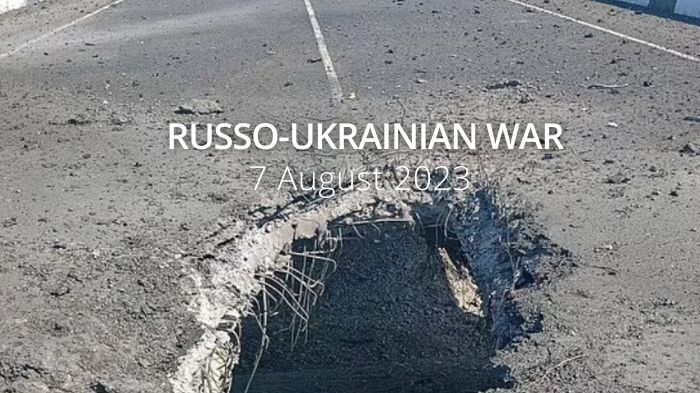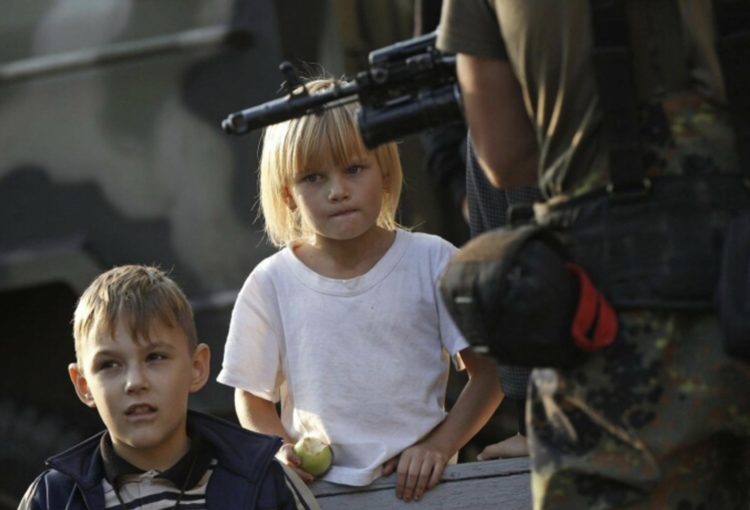UN issues warning as “drums of nuclear war are beating again.” Russians report strikes on Chonhar bridge. Russians launch a massive air strike; Ukrainian air defense destroys 30 cruise missiles and 27 strike drones.
Daily report day 530 – August 7, 2023

According to information from the General Staff as of 06.00 07.08.2023, supplemented by its [18:00 assessment].
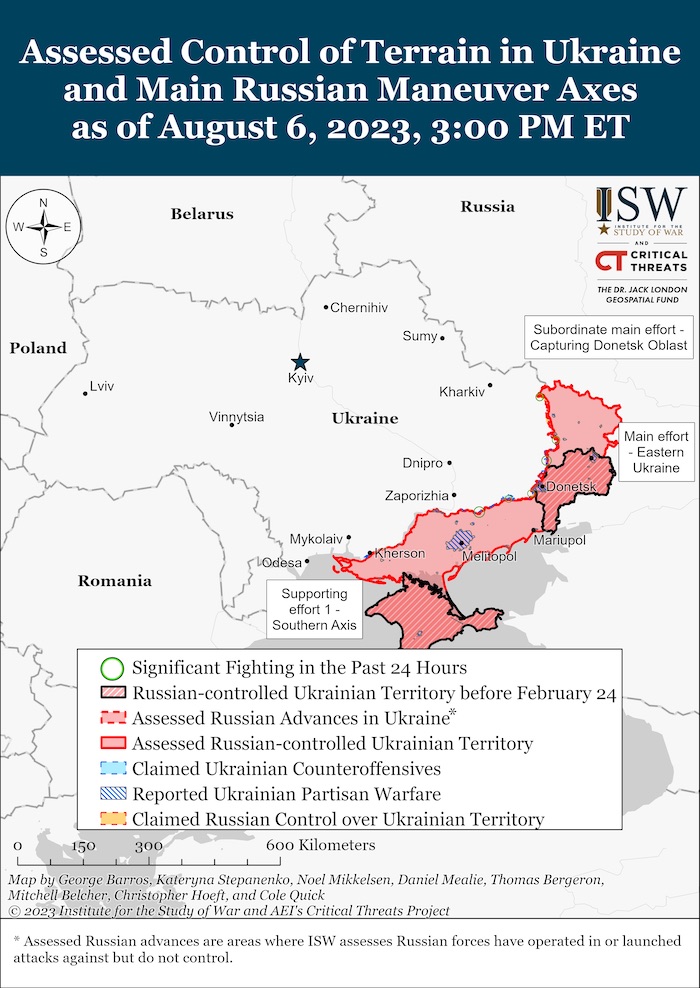
“Over the past 24 hours, the enemy launched 30 missiles and 52 airstrikes, launched 75 attacks from rocket salvo systems on the positions of our troops and populated areas. As a result of the Russian terrorist attacks, unfortunately, there are dead and wounded among the civilian population, and residential buildings and other civil infrastructure were destroyed.
The probability of launching missiles and airstrikes on the entire territory of Ukraine remains high.
50 combat clashes took place during the day.
- Volyn and Polissya axes: the operational situation has not changed significantly.

- Sivershchyna and Slobozhanshchyna axes: the enemy carried out mortar and artillery attacks on more than 35 settlements, in particular, Buchki, Gremyach, Vesele of the Chernihiv region; Seredyna-Buda, Sydorivka, Studenok, Basivka, Velika Pisarivka in the Sumy region and Gur’iv Kozachok, Strelecha, Gatishche, Potykhonov, Odradne and Bologivka in the Kharkiv region.
- Kupiansk axis: our soldiers are firmly holding the defence, and successfully repulsed enemy attacks in the area east of Petropavlivka, Kharkiv region. The enemy carried out airstrikes in the Petropavlivka and Podoli districts of the Kharkiv region. The enemy subjected more than 10 settlements to artillery and mortar fire, among them Figolivka, Dvorichna, Kindrashivka, Kucherivka, Kupiansk and Kislivka of the Kharkiv region.
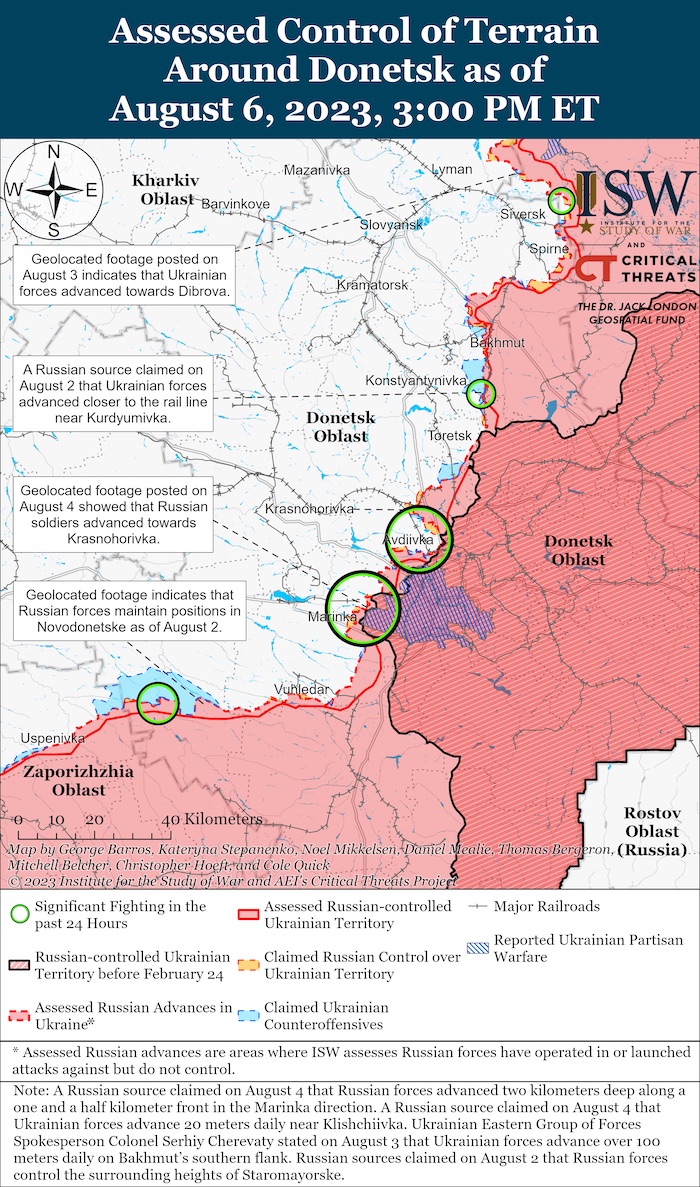
- Lyman axis: the enemy carried out airstrikes in the areas of Bilogorivka, Luhansk region, and Spirny and Rozdolivka, Donetsk region. The settlements of Kuzmine, Bilogorivka in the Luhansk region and Torske, Verkhnyokamianske, Spirne, Berestov and Rozdolivka in the Donetsk region were hit by enemy artillery fire.
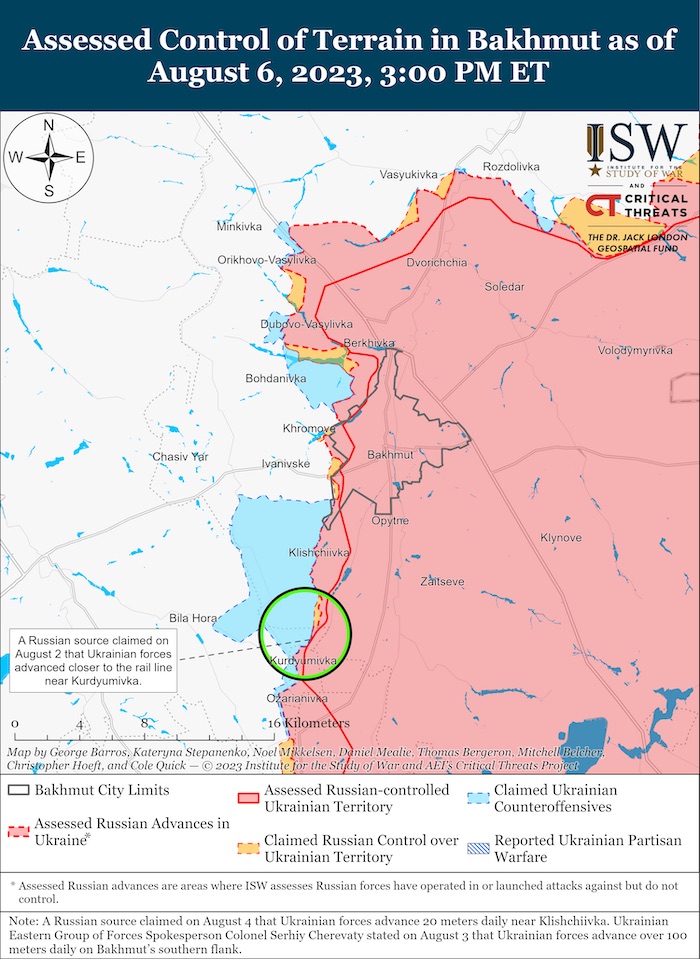
- Bakhmut axis: defence forces are restraining the enemy in the area northeast of Diliivka. More than 15 settlements, including Vasyukivka, Bohdanivka, Bakhmut, Ivanivske, Klishchiivka, and North of the Donetsk region, were affected by enemy artillery shelling.
- Avdiivka axis: under heavy fire from the enemy’s aircraft and artillery, our defenders successfully repelled attacks by Russian troops in the Avdiivka area. Avdiivka and Pervomaiske of the Donetsk region were hit by artillery fire.
- Mariinka axis: the defence forces continue to hold back the advance of Russian troops in the areas of Marinka and Krasnohorivka. Near the last one, the enemy launched an airstrike. Krasnohorivka, Maksimilianivka, Georgiivka, Pobyeda and Novomykhailivka of the Donetsk region were hit by artillery fire.
- Shakhtarske axis: the enemy launched an airstrike in the Staromayorsky area. Vodyane, Vugledar, Odradne, Blagodatne and Rivnopil of the Donetsk region were hit by artillery fire.

- Zaporizhzhia axis: the enemy carried out unsuccessful offensive actions in the Robotyn region of the Zaporizhzhia region. The enemy carried out airstrikes in the areas of Mala Tokmachka, Robotyny, and Orikhov. More than 15 settlements, including Levadne, Chervone, Zaliznychne, Pavlivka, Pyatikhatky and Kamianske of the Zaporizhzhia region, as well as Nikopol of the Dnipropetrovsk region, were affected by enemy artillery shelling.
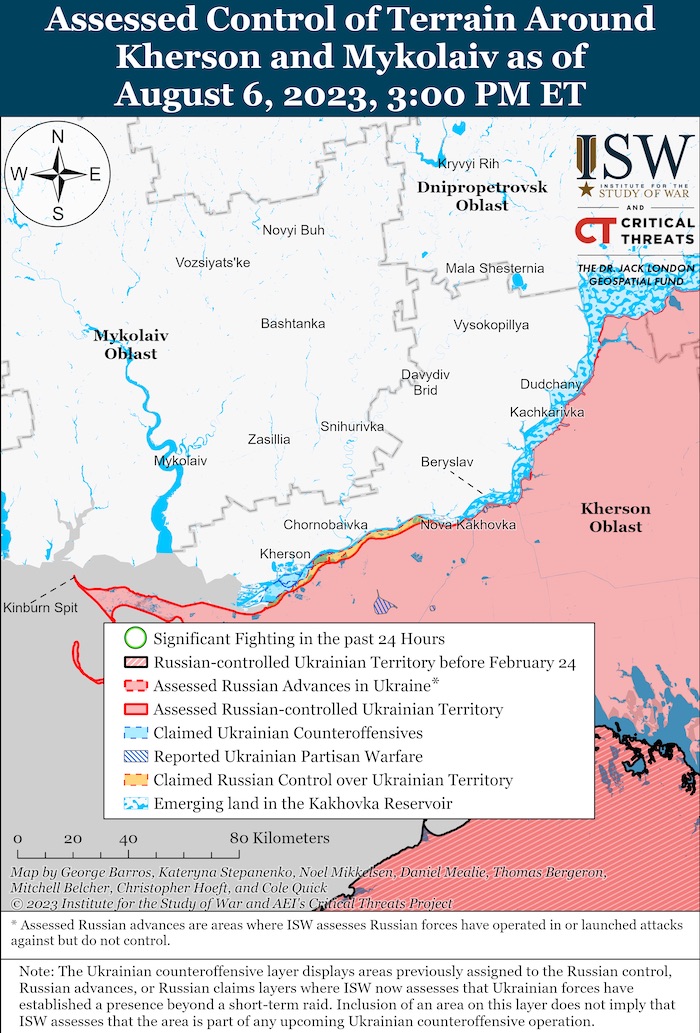
- Kherson axis: the enemy launched an airstrike in the Olhivka area of the Kherson region. More than 20 settlements, including Mykhailivka, Respublikanets, Lviv, Dniprovske, Veletenske and Novodmytrivka of the Kherson region, were affected by enemy artillery shelling.
[At the same time, the Defense Forces of Ukraine continue to conduct an offensive operation in the Melitopol and Berdiansk axes, are entrenched at the reached boundaries, and carry out counter-battery countermeasures.]
The enemy continues to suffer heavy losses, which he tries to hide in every way. Thus, in the temporarily captured settlement of Chaplinka, Kherson region, two trucks with the bodies of servicemen of the Russian army arrived at the territory of the morgue from the Kherson direction. The bodies were buried in two locations.
On August 6, the Ukrainian air force launched 10 strikes on enemy personnel concentration areas and 4 strikes on the occupiers’ anti-aircraft missile complexes.
During the day, Ukrainian missile and artillery troops hit 2 control points, 2 areas of concentration of personnel, 2 artillery means in firing positions and one radio-electronic warfare station of the enemy.“
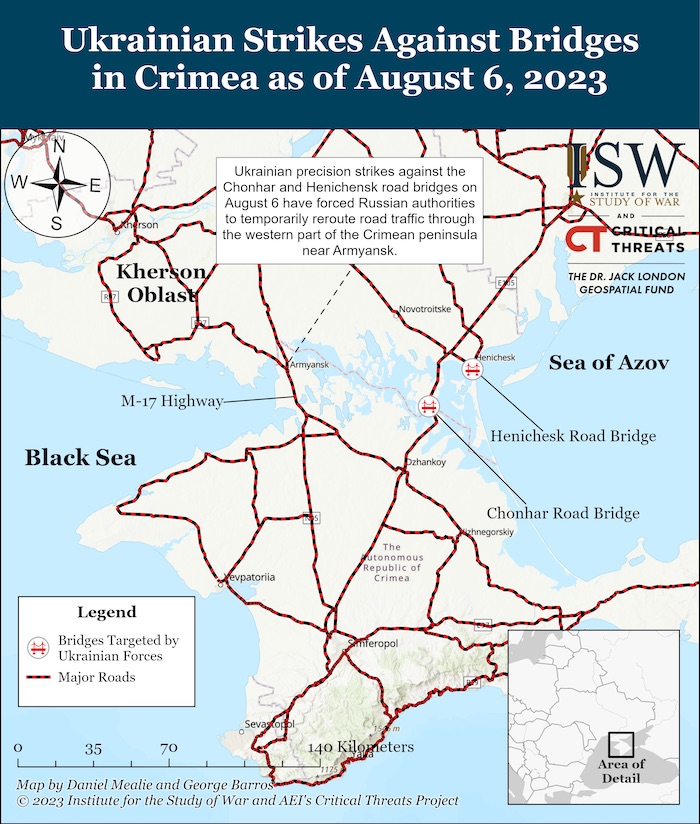
Russians report Ukrainian attack on Hanichensk bridge, Ukrainska Pravda reports, citing Volodymyr Saldo on Telegram. “Volodymyr Saldo, Russian-appointed puppet leader in Kherson Oblast, has said that the Armed Forces of Ukraine struck the bridge across the Henichesk Strait connecting occupied Henichesk with the Arabat Spit. According to the collaborator, the Ukrainian Defenсe Forces launched 12 missiles on the bridge; 9 were shot down by Russian air defence. One civilian driving over the bridge was allegedly injured by the strike.
The Strilkove field – Henichesk gas pipeline running next to the bridge was also blocked. More than 20,000 city residents were left without gas supply, said Saldo.”
Military Updates
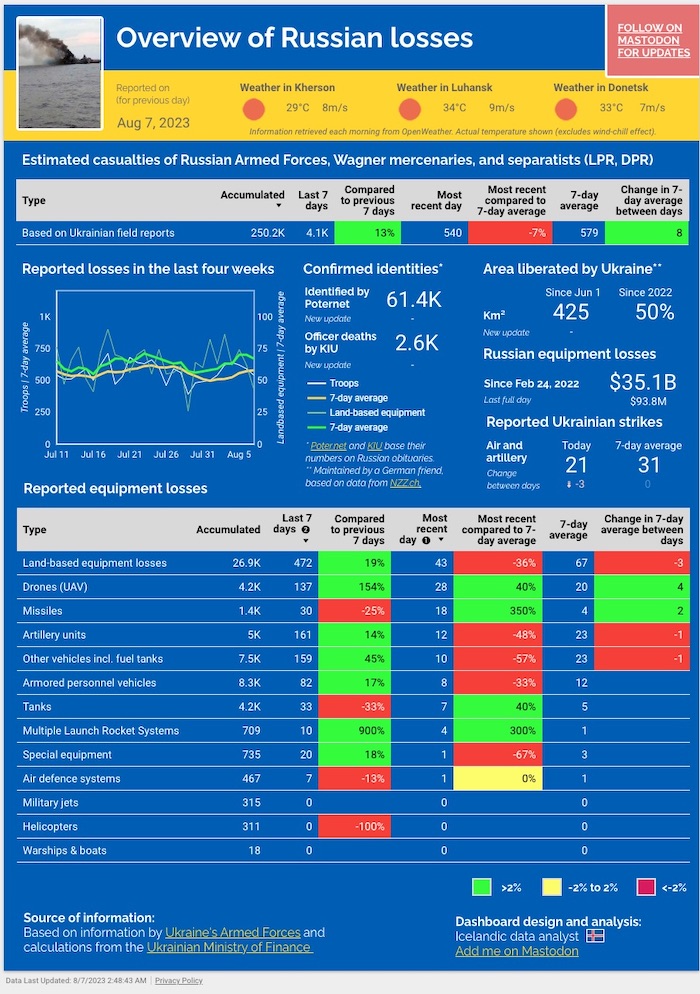
Russians report strikes on Chonhar bridge, Ukrainska Pravda reports, citing Russian news agency RBC, quoting Vladimir Rogov, Russian-appointed puppet leader in Zaporizhzhia Oblast. “Russians report a missile strike that supposedly occurred on the Chonhar bridge, which connects Crimea with the Kherson Oblast. In total, three or four strikes are reported. The extent of damage is still unknown. Russia has not yet not provided any other information. The Russians have also blocked the bridge.”
Moscow’s Vnukovo airport closed due to supposed risk of UAV attack, Ukrainska Pravda reports, citing Russian state-owned news agency TASS; Mash Telegram channel; Moscow Mayor Sergei Sobyanin, on Telegram. “The Russian airport of Vnukovo was closed for takeoff and landing on the afternoon of 6 August, allegedly due to dangerous targets in the sky. Vnukovo Airport has temporarily limited the landing and take-off of civilian aircraft.
The Mash Telegram channel writes that the restriction of landings and takeoffs was introduced in the airspace over the airport. Usually, this is implemented when “dangerous or unknown objects” are spotted in the sky. Meanwhile, Sobyanin claimed that at around 11:00, there was an attempt of a drone breaking through to Moscow. The drone was reportedly shot down.”
Ukraine’s forces destroy six Russian ammo depots, and 21 units of military hardware in the Tavria axis, Ukrinform reports, citing the Commander of the Tavria Operational-Strategic Group of Troops, General Oleksandr Tarnavskyi. “During the day, Ukraine’s defence forces in the Tavria operational war zone carried out 1,477 fire missions, destroying 21 units of Russian military equipment and six ammunition depots.
Over the past day, the enemy attacked our positions 21 times, firing off 608 projectiles. Artillery units of the Tavria Group’s Defense Forces performed 1,344 fire missions. Over the last day, Russia’s losses in terms of killed and wounded in action amounted to almost two companies, said Tarnavskyi.
According to the official, 21 units of Russian military equipment were destroyed, including three armoured fighting vehicles, 10 artillery systems and mortars, two unmanned aerial vehicles, four trucks, and two units of specialized equipment. Ukraine’s forces also devastated six ammunition depots.”
30 cruise missiles and 27 strike drones destroyed, the Ukrainian General Staff reports. “In the period from the evening of August 5 to the morning of August 6, 2023, the Russian invaders launched a massive missile attack on the territory of Ukraine with air and sea-based missiles, as well as Iranian attack drones of the “Shahed” type. In the first wave, on the evening of August 5, the enemy used 14 Kalibr sea-based cruise missiles and three Kh-47 Kinzhal aeroballistic missiles. 12 out of 14 Kalibr were destroyed by anti-aircraft defense. We do not disclose information about “Daggers”.
On the night of August 6, the enemy continued to attack with “Shahed” attack UAVs from the southeast, “Kalibr” cruise missiles from the Black Sea area, and Kh-101/Kh-555 cruise missiles from Tu-95MS strategic aircraft from the Caspian region. The forces and means of the Air Force, in cooperation with the air defence of other components of the Défense Forces of Ukraine, destroyed all 27 Shahed-136/131 attack UAVs, 5 of 6 Kalibr missiles (second wave) and 13 of 20 air-based cruise missiles X -101/X555.
So, in total, in several waves of attacks, from the evening of August 5 to the morning of August 6, 2023, the enemy used 70 means of air attack. Anti-aircraft defense destroyed: 17 Kalibr cruise missiles; 13 Kh-101/Kh-555 cruise missiles; and 27 attack UAVs “Shahed-136/131”.”
Ihnat about difficulty of shooting down “Kalibrs” launched from submarines: Little time to react, Censor.net reports, citing the spokesman of the Air Force of the Ukrainian Armed Forces, Yuriy Ihnat, with reference to ZN.ua. “Kalibr missiles, often launched by the enemy from submarines, are difficult to shoot down because they can fly low. According to him, the submarine strikes unexpectedly because it is not known where it is. Accordingly, there is little time to react if he is close to the potential location of the target, Ihnat emphasized. He also informed that Kalibr missiles can also fly low – this makes it difficult to detect them by radar means and shoot them down.
The spokesman also said that Kh-22 missiles can be shot down only by ballistic means. He also added that it is almost impossible to shoot down Russian Onyx missiles by any air defense means because they fly very low – 10-15 meters above the water level.”
Ukrainian Air Force explains why targeting Ukrainian airfields is ineffective, Ukrainska Pravda reports. “On Saturday evening, Russian troops launched Kinzhal aeroballistic missiles from Tambov Oblast and Belarus. Ukraine’s Air Force specified that the missiles were flying in the direction of the city of Starokostiantyniv, Khmelnytskyi Oblast. […] About ten explosions were heard in Starokostiantyniv, Khmelnytskyi Oblast. Smoke was visible over the city, and windows in some districts were smashed.
Ukrainian Air Force spokesman Yurii Ihnat has noted, in the wake of the Russian shelling of the airfield in Starokostiantyniv, Khmelnytskyi Oblast, that pilots move their aircraft to other Ukrainian airfields in the event of Russian strikes.
This is not the first time this airfield has been attacked. It’s the permanent base of a tactical aviation brigade. But our aircraft are quite mobile, our pilots know how to counteract the enemy in these conditions. We have dozens of operational airfields in the country. Therefore, the enemy will not be able to destroy our aircraft so easily… […] Ihnat was referring to the protocol that enables pilots to redeploy aircraft to other airfields if there is a possibility of incoming Russian strikes.
Even before the air defence systems went online and explosions began yesterday, the Air Force posted on social media that missiles were in the air and that their likely direction was Starokostiantyniv.”
According to British Defence Intelligence, (last 48 hours):
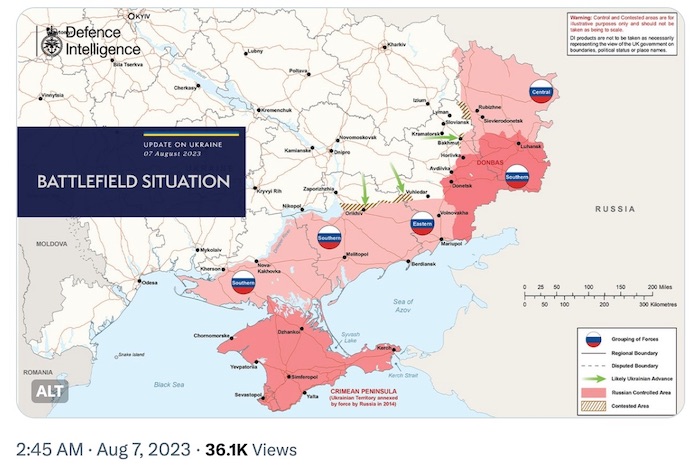
- The Russian Air Force continues to consistently deploy considerable resources in support of land operations in Ukraine, but without decisive operational effect.
- Over the summer, Russian tactical combat aircraft have typically carried out over 100 sorties a day, but these are almost always restricted to operating over Russian-controlled territory due to the threat from Ukrainian air defences. Russia has attempted to overcome this issue by increasingly using basic free-fall bombs with range-extending glide attachments. Aircraft can release these many kilometres from their targets, but they have yet to demonstrate consistent accuracy.
- At the start of Ukraine’s southern counter-offensive from June 2023, Russian attack helicopters proved effective. However, in recent weeks Russia appears to have been less able to generate effective tactical airpower in the south.
- The annual celebrations of Russia’s Airborne Forces (VDV) Day on 2 August 2023 have been overshadowed by an apparently unsanctioned disclosure of the scope of the casualties the elite force has suffered in Ukraine.
- In a recorded address for VDV Day, the VDV’s Commander-in-Chief General Colonel Mikhail Teplinsky said that 8500 paratroopers had been wounded and later returned to duty or had refused to leave the front line at all. The video was quickly deleted from the Russian MoD’s official channels.
- He did not comment on how many troops had been killed or were too seriously wounded to return to duty. However, extrapolating Teplinksy’s figures endorses the assessment that at least 50 per cent of the 30,000 paratroopers who deployed to Ukraine in 2022 have been killed or wounded.
Losses of the Russian army
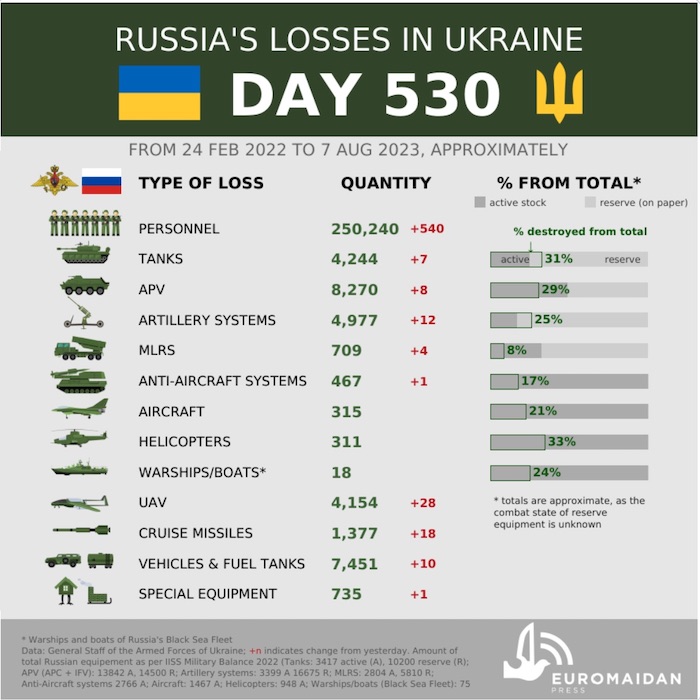
As of Monday 7 August, the approximate losses of weapons and military equipment of the Russian Armed Forces from the beginning of the invasion to the present day:
- Personnel – about 250240 (+540)
- Tanks – 4244 (+7)
- Armoured combat vehicles – 8270 (+8)
- Artillery systems – 4977 (+12)
- Multiple rocket launchers –MLRS – 709 (+4)
- Air defence means – 467 (+1)
- Aircraft – 315 (+0)
- Helicopters – 311 (+0)
- Automotive technology and fuel tanks – 7451 (+10) 7441 (+19)
- Vessels/boats – 18 (+0)
- UAV operational and tactical level – 4154 (+28)
- Special equipment – 735 (+1)
- Mobile SRBM system – 4 (+0)
- Cruise missiles – 1377 (+18)
During week, Defense Forces destroyed 4,000 occupiers and 616 units of enemy military equipment, Censor.net reports, citing Deputy Minister of Defense of Ukraine Lieutenant-General Oleksandr Pavliuk. “During the week, defenders of Ukraine destroyed about 4,000 personnel of the Russian occupiers and 616 units of various weapons and military equipment of the enemy.
Armaments/military equipment of Russian troops suffered significant losses: 32 tanks, 84 armored combat vehicles, 170 artillery systems, 7 anti-aircraft guns, 7 air defense systems, 166 vehicles, 23 special vehicles, Pavliuk noted.
According to him, the Defense Forces shot down 12 missiles and 115 unmanned aerial vehicles of the Russian invaders in a week.”
We are proud of heroes of sky! Already more than 14 thousand combat sorties of our aviation, Censor.net reports, citing President Zelensky. “President of Ukraine Volodymyr Zelenskyy has congratulated the servicemen of the Ukrainian Air Force on their professional holiday.
Day of the Air Force of the Armed Forces of Ukraine! We are proud of our heroes of the sky! Our aviation has already completed more than 14,000 combat missions during the war. Each one is a heroism. Each one is a result for Ukraine. Each one is a step closer to our victory. I thank all the soldiers of the Ukrainian Air Force – all the aviators, our anti-aircraft gunners, and specialists of the radio engineering troops! Glory to you! Glory to Ukraine! he said in a statement.
Earlier, Air Force Commander Lieutenant General Mykola Oleshchuk noted that since 24 February 2022, the Air Force of Ukraine has destroyed 350 enemy planes and helicopters and more than 2,000 enemy drones.”
Humanitarian
Humanitarian corridor reopens on Ukraine-Russia border in Sumy region, Ukrinform reports, citing the Ukrainian Ministry of Temporarily Occupied Territories Reintegration. “Ukrainians, evacuating from the temporarily occupied areas, can return to the Ukrainian-controlled territory via the checkpoint Kolotilovka (Russia)-Pokrovka (Ukraine). Starting from yesterday, the checkpoint on the border between the Belgorod region and the Sumy region resumed operation,” the report states.
A humanitarian center was set up at the Ukrainian border, where all Ukrainians can receive free psychological, legal and humanitarian aid, as well as stay overnight and get to the city of Sumy or any other place.
The ministry mentioned that those willing to evacuate from the Sumy region can use the Sumy-Kyiv evacuation train running on a daily basis. Kyiv Regional Military Administration will offer such people accommodation in a modular town in the Vyshhorod district.”
Another silo on fire as Russian missiles target Ukrainian grain, Ukrinform reports, citing Khmelnytskyi Regional Military Administration. “In Ukraine’s Khmelnytskyi region, firefighters scrambled to the scene of a Russian missile strike overnight Sunday where a grain silo was caught ablaze. This is how our heroes are standing, without weapons, against the fire that broke out as a result of an attack on Khmelnytskyi region. There was a fire at the silo in the Starokostyantinivka community, the post reads.
Earlier it was reported that on the evening of August 5 and overnight Sunday, August 6, Russian missiles and drones attacked objects across Khmelnytskyi region in three waves. A series of explosions were reported in the Starokostyantiniv and Khmelnytskyi communities.
As a result of the enemy strike, a fire broke out in the corn waste warehouse on the silo premises in the Starokostyantiniv community. The fire was contained on an area of 1,400 square meters. A silo employee sustained injuries as a result of the strike. As reported by the local administration, Ukraine’s air defense forces shot down most of the incoming air targets.”
Russia uses its best weapon to destroy Ukrainian grain, – UK Ministry of Defense, Censor.net reports, citing Sky News with reference to the UK Ministry of Defense. “The statement said that since Russia finally withdrew from the Black Sea grain initiative on July 17, thousands of tons of grain have been destroyed.
Russia has been using “the best weapons” to target elevators and infrastructure, including X-22 missiles, a 5.5-ton munition originally designed to hit aircraft carriers. It is noted that the destruction of infrastructure and the grain itself has led to an increase in the cost of food in African countries that depend on supplies from Ukraine.”
NCER says just 1.6% of energy objects damaged in Russian attacks renovated so far, Ukrinform reports, citing Kostiantyn Ushchapovskyi, the Head of the Ukrainian National Commission for Energy, Housing and Utility Services Regulation (NCER) and the Verkhovna Rada Committee on Energy, Housing and Utility Services. “Just 1.6% of the Ukrainian energy objects affected by Russian attacks have been renovated. Unfortunately, the figures that we have today regarding the completion of emergency and renovation works, as of July 1, 2023, do not allow us to think positively about passing through the heating winter period smoothly,” Ushchapovskyi noted.
In his words, the power grids of Ukrenergo National Power Company suffered losses worth UAH 9.6 billion. However, it is just UAH 681 million worth of renovation works that have been completed.
A reminder that last autumn and winter Russians were actively attacking Ukraine’s energy infrastructure. The Ukrainian Energy Ministry had to introduce emergency power outages for household consumers. Despite the challenging winter period, the enemy’s plan to cause a complete blackout in Ukraine failed.”
Interior Ministry says idea of banning males from crossing out of Ukraine after war-end ex-advisor’s personal opinion, Ukrinform reports, citing the press service of the Ukrainian Ministry of Internal Affairs. to Telegram to post its commentary, Ukrinform reports. “The Ministry of Internal Affairs went public to distance itself from the former advisor to the minister, Vadym Denysenko, whose recent comment on the need to bar male Ukrainians from crossing out of Ukraine at least for three years after the war ends sparked outrage across social media.
In response to numerous inquiries from journalists, I am officially informing you that Vadym Denysenko is not an advisor to the Minister of Internal Affairs, said the spokeswoman of the Ministry, Maryana Reva. The spokesperson noted that Denysenko’s statement is his personal opinion not reflecting the one of the ministry.
Denysenko, who now heads a private think tank, the Ukrainian Institute for the Future, on August 6 posted a Facebook entry, in which he expressed the opinion that after the end of the war, the ban on Ukrainian men traveling abroad should be extended for at least another three years. As reported, one of the National Academy of Sciences’ research institutes believes that among factors that can potentially contribute to the displaced Ukrainians returning home are ties with Ukraine, security, accommodation, and jobs.”
Environmental
UN issues warning as “drums of nuclear war are beating again”, Ukrinform reports, citing UN News. “In a message to mark the 78th anniversary of the atomic bombing of Hiroshima, Mr. Guterres urged the international community to learn from the “nuclear cataclysm” that befell the Japanese city on August 6, 1945. The drums of nuclear war are beating once again; mistrust and division are on the rise, the UN chief said in a statement to the Hiroshima Peace Memorial, delivered by UN’s High Representative for Disarmament Affairs, Izumi Nakamitsu.
The nuclear shadow that loomed over the Cold War has re-emerged. And some countries are recklessly rattling the nuclear sabre once again, threatening to use these tools of annihilation.
Non-proliferation treaty talks are taking place at the UN in the Austrian capital until August 11, where Ms. Nakamitsu reiterated her warning to the forum that not since the depths of the Cold War has the risk of a nuclear weapon being used so high – just as the rules-based order intended to prevent their use has never been so fragile.
The 1968 Nuclear Non-proliferation Treaty (NPT) is one of the only international agreements signed by both nuclear and non-nuclear states, aimed at preventing the spread of nuclear weapons and furthering the goal of nuclear disarmament. After entering into force in 1970, 191 states have since become party to the treaty – the most signatories of any arms limitation agreement.”
Legal
Occupiers sent hundreds of children from Zaporizhzhia region for “re-education” to Chuvashia, Saratov region and Penza, Censor.net reports, citing Melitopol Mayor Ivan Fedorov. “In the occupied territories of the Zaporizhzhia region, the Ruscists continue to put pressure on parents and children. As noted, the occupiers are going house to house to identify persons who refuse to send their children to Russian schools. In addition, Ukrainian children are being deported to Russia under the guise of “adoption”. Under the pretext of “rest” or “military-patriotic education”, children are taken to the hinterlands of Russia.
Only in the last two months, hundreds of children from TOT of the Zaporizhzhia region have sent: 1,600 km to Chuvashia to “rest”; 1,400 km to the Saratov region to “rest”; 1,200 km to Penza for the participation of representatives of the “Unarmy” in the military-patriotic meeting of the Volga Federal District “Gvardiets”, Fedorov said.
As Fedorov noted, the parents of Melitopol were separately offered an August vacation for their children in Yevpatoria in Crimea, but they refused to make the children human shields for the occupiers.”
Heads of foreign ministries of Czech Republic and France condemned attack by Russian Federation on blood transfusion center in Kharkiv region, Censor.net reports, citing European Truth. “The foreign ministers of the Czech Republic and France reacted to the latest massive Russian missile attacks on the cities of Ukraine, in particular the attack on the blood transfusion center in the Kharkiv region.
The head of the French Foreign Ministry, Catherine Colonna, said that she “strongly condemns” Russia’s massive missile attacks on August 5-6, in particular on the blood transfusion center in the Kharkiv region, and emphasized that the deliberate targeting of civilian objects is a war crime. The minister added that France, in cooperation with other allies, will continue to help Ukraine further exercise its right to self-defence, as well as support the work of Ukrainian authorities and the International Criminal Court to bring to justice those involved in Russian war crimes.
The attack on the blood transfusion center in the Kharkiv Region is yet another proof of Russia’s inhumane behavior. Those responsible for this act of terror must be punished, and the Czech Republic will make every effort to do so, said the head of the Czech Foreign Ministry, Jan Lipavsky.”
Support
This week enemy fired 65 missiles and 178 attack drones at Ukraine, – Zelensky, Censor.net reports, citing President Zelensky in his video appeal. “This week alone, Russian terrorists have already used 65 different missiles and 178 attack drones against us, including 87 “Shaheeds”. We managed to shoot down a significant number of them, he said.
Here, in our skies, we can prove that terror is losing. All together we can prove it – all partners. The responsible position of each partner in supplying air defence systems and missiles to them is very important, Zelenskyy emphasized.
He noted that Ukraine needs full protection from terror so that it does not have to think about how to protect other nations from it. Zelensky also said today that by creating its own air shield, Ukraine is creating the basis for an air shield for the whole of Europe.”
No country in the world has such experience in repelling massive air attacks as Ukraine — Ihnat, Ukrinform reports. “Yuriy Ihnat, the spokesman for the Air Force of the Armed Forces of Ukraine, has stated that no country in the world has such experience in repelling massive air attacks launched with all available modern means as Ukraine. The Air Force has undergone a transformation of armaments. We have more equipment that protects the Ukrainian sky. These are Patriot, IRIS-T, and NASAMS systems. And we expect further transformation, namely the provision of aircraft to Ukraine, modern jets such as F-16s which will significantly strengthen our air defence and help ground troops, Ihnat said […]. At the same time, he noted that the transformation of the Air Force takes place not only in the provision of equipment but also in the training of our personnel.
No country in the world has such experience in repelling massive air attacks launched with all available modern means of destruction. Unfortunately, Russia has them, Russia has been investing huge sums of money in it for decades, and today it uses them to attack. Therefore, the NATO countries will greatly need the experience that the Ukrainian military has today. And we also want to become a part of this organization so that peace and security in the whole world are stable and such horror as Russia has inflicted on us is never repeated, Ihnat emphasized. Also, the Air Force spokesman clarified that Ukraine has yet to master F-16 aircraft.
He noted that from the evening of August 5 to the morning of August 6, Russia used 70 means of air attack on the territory of Ukraine. The enemy launched Shahed drones, Kinzhal, Kalibr, Kh-101, Kh-555 missiles on the territory of our state. Fifty-seven air targets were destroyed. Indeed, our [air defence] forces did everything possible to repel this air attack. Today is Air Force Day. Perhaps, the enemy actually planned to ‘congratulate’ our defenders of the sky in this way, but he did not succeed. And I think that we will continue to build up our efforts to nullify the enemy’s aggression, the Air Force spokesman emphasized.”
Czech Republic hands over simulator for F-16 pilot training to Ukraine, Censor.net reports, citing the site of President. “On the Air Force Day, President of Ukraine Volodymyr Zelensky saw the F-16 fighter jet control simulator, which was donated by the Czech Republic, in operation. Using this simulator, the Ukrainian military is currently studying the features of modern equipment and its capabilities, the statement said.”
German ruling party doesn’t exclude possible transfer of Taurus missiles to Ukraine, Ukrinform reports. “The Social Democratic Party of Germany (SPD), which belongs to the ruling coalition, does not exclude the possible transfer of Taurus cruise missiles to Ukraine. I do not rule out the possibility that we, in alliance with the Americans, will also supply additional systems, such as Taurus, said Nils Schmid, SPD parliamentary group’s spokesperson for foreign affairs in the Bundestag, DW reports.
But first, according to him, it is necessary to make sure that the Ukrainians themselves can program missiles to reach a target and do not need the Bundeswehr military for this. Otherwise, we will come dangerously close to direct intervention in the war, the politician told Tagesspiegel in an interview. However, he does not see the need to make a relevant decision right now. I share the defence minister’s assessment, Schmid explained.
Earlier, Bundestag MP from SPD Andreas Schwartz also offered to support the counteroffensive of the Armed Forces of Ukraine with cruise missiles. The counteroffensive is stalling, Ukraine does not have a significant air force to support it. Therefore, only guided weapons remain – for example, Taurus cruise missiles, with the help of which the Ukrainian army can overcome the minefields installed by the Russians and win back its territory, Schwartz said.
As reported, Ukraine has been asking Germany to provide Taurus cruise missiles with a range of up to 500 km since the beginning of summer. However, German Defense Minister Boris Pistorius said that Berlin was not considering the possibility of transferring Taurus missiles to Ukraine in the foreseeable future due to fears that the German weapons could be used to strike Russian territory.”
New developments
- Kremlin says they only want Ukrainian territories included in Russian Constitution, Ukrainska Pravda reports, citing The New York Times. “Dmitry Peskov, Spokesman for the Russian dictator, has said Russia allegedly does not want any other Ukraine’s territories, just the four oblasts and Crimea that were illegally included in the Russian Constitution. […] Peskov also stated there are currently “no grounds” for a peace agreement with Ukraine. We will continue the operation [war – ed.] for the foreseeable future, Peskov said.”
- Most of 40 countries decide how they will work for peace after meeting in Saudi Arabia, Ukrainska Pravda reports. “Andrii Yermak, the head of the Office of the President, spoke about the results of the meeting in Saudi Arabia regarding the implementation of the Ukrainian Peace Formula and noted that most of the participating states have decided how they will make their contribution. Yermak clarified the list of about 40 participating countries, which was not fully revealed until now: from Europe: Bulgaria, the United Kingdom, Denmark, Estonia, Spain, Italy, Latvia, Lithuania, Netherlands, Germany, Norway, Poland, Romania, Slovakia, Finland, France, Czechia, Sweden, and the EU as a union; from the Middle East and Asia: Saudi Arabia, Australia, Bahrain, India, Jordan, Qatar, Kuwait, the Union of Comoros Islands, China, Korea, Türkiye, Japan; from Africa: Egypt, South Africa; from North America: Canada and the USA; from South America: Argentina, Brazil, Chile, and the UN as an organisation. [All BRICS countries except Russia]”
- Ukraine calls Jeddah talks productive, Russia calls them doomed, Reuters reports. “A senior Ukrainian official said on Sunday that talks in Saudi Arabia to make headway towards a peaceful settlement of the war with Russia had been productive, but Moscow called the meeting a doomed attempt to swing the Global South behind Kyiv. […] Ukraine and its allies called the talks an attempt to secure broad international support for principles that Kyiv wants to be the basis for peace, including the withdrawal of all Russian troops and the return of all Ukrainian territory to its control. […] Russian Deputy Foreign Minister Sergei Ryabkov was quoted by state media on Sunday as saying the meeting was “a reflection of the West’s attempt to continue futile, doomed efforts” to mobilise the Global South behind Zelenskyy’s position. […] The participation of China, which stayed away from an earlier round of talks in Copenhagen and has shunned Western calls to condemn Russia’s invasion, signalled a possible shift in its stance but not a major change, analysts said.”
- China supports further negotiations on Ukrainian peace formula, Censor.net reports, citing The Guardian. “China’s Eurasian Affairs Representative Li Hui welcomed the idea of holding future summits in the same format as the one held in Jeddah. We have many differences and we have heard different positions, but it is important that our principles are common, Lee said before the meeting. An unnamed source from the EU said that the representative of China took an active part and was positive about the idea of a third meeting in the same format. It is noted that the participation of China is a great diplomatic success of Ukraine, because at the previous meeting, which took place in Copenhagen, there was no representative of China, although he was invited.”
- Participants of summit in Saudi Arabia agreed that respect for territorial integrity and sovereignty of Ukraine should be basis of peaceful settlement, Censor.net reports, citing Reuters. “The participants of the summit on the Ukrainian peace formula, which is taking place in Jeddah, agree that the basis of any peaceful settlement of Russia’s war against Ukraine should be respect for the territorial integrity and sovereignty of Ukraine. It is noted that the representative of the EU described the negotiations as positive and pointed out that the participants of the meeting reached an agreement that respect for the territorial integrity and sovereignty of Ukraine should be the basis of any peaceful settlement. The representative of the European Union said that there will be no joint statement after the meeting, but the Saudis will present a plan for further negotiations with working groups to discuss such issues as global food security, nuclear security, and the release of prisoners, the report said.”
- Putin’s administration claims he would get more than 90% of vote in elections, Ukrainska Pravda reports, citing The New York Times. “Dmitry Peskov, a spokesman for the Russian dictator, claimed that Vladimir Putin will be re-elected in the presidential election next year with a result of more than 90% of the vote. […] The New York Times, referring to the results of the Levada Center pollster, notes that Putin’s popularity fell only once in September last year, when a partial mobilisation was announced in the Russian Federation. Denis Volkov, director of the Levada Center, says that the drop in support for Putin was the largest in 30 years of polls – from about 80% to 50%. Since then, the level of support for Putin has returned to about 80%, as far as polls can be trusted in the current conditions, the newspaper writes.”
Assessment
- On the War
The Institute for the Study of War has made the following assessment as of Sunday 6 August:
(quote) “The Russian Ministry of Defense (MoD) claimed that Ukrainian forces conducted offensive operations along the Kupiansk-Svatove-Kreminna line but did not advance on August 6. The Russian MoD claimed that Ukrainian forces unsuccessfully attacked Russian forces near Synkivka (8km northeast of Kupiansk), Vilshana (15km northeast of Kupiansk), Novoselivske (14km northwest of Svatove), southwest of Kovalivka (10km southwest of Svatove), and near the Serebryanske forest area (10km southwest of Kreminna).
Russian forces conducted offensive operations along the Kupiansk-Svatove-Kreminna line on August 6 and reportedly advanced. The Ukrainian General Staff reported that Russian forces unsuccessfully attacked Ukrainian forces near Petropavlivka (7km east of Kupiansk), Vilshana, Synkivka, and Bilohorivka (12km south of Kreminna). Russian Western Grouping of Forces Spokesperson Sergey Zybinsky claimed that Russian assault groups of the 6th Combined Arms Army (Western Military District) advanced into Ukrainian defenses near Vilshana. Some Russian milbloggers claimed that Russian forces took control of Novoselivske on August 5. A Kremlin-affiliated milblogger claimed that Russian forces ”decisively” captured Novoselivske after several months of fighting and pushed Ukrainian forces out of their last positions in the western part of the settlement on August 5. The milblogger claimed that fierce fighting continues for the heights south of Novoselivske. ISW has not yet observed visual confirmation of these claims.
Ukrainian forces reportedly conducted offensive operations near Bakhmut on August 6, but did not make any confirmed or claimed gains. Ukrainian Main Military Intelligence Directorate (GUR) Head Major General Kyrylo Budanov stated in an interview published on August 5 that Ukrainian forces are advancing faster around Bakhmut than in southern Ukraine. The Russian Ministry of Defense (MoD) and other Russian sources claimed that elements of the Russian Southern Grouping of Forces repelled Ukrainian attacks near Klishchiivka (7km southwest of Bakhmut). A Russian milblogger claimed that Russian and Ukrainian artillery strikes are preventing either side from gaining a foothold or the initiative near Klishchiivka, however. A Russian milblogger claimed that unspecified Russian airborne units (VDV) repelled a Ukrainian attack near Berkhivka (6km northwest of Bakhmut).
Russian forces conducted offensive operations near Bakhmut on August 6, but did not make any confirmed or claimed gains. The Ukrainian General Staff reported that Russian forces conducted unsuccessful attacks near Kurdyumivka (12km southwest of Bakhmut) and northeast of Dyliivka (15km southwest of Bakhmut). […]
The Russian MoD claimed that Ukrainian forces conducted limited ground attacks along the Avdiivka-Donetsk City line and did not advance on August 6. The Russian MoD claimed that elements of the Southern Grouping of Forces repelled Ukrainian attacks near Pervomaiske (11km southwest of Avdiivka), Nevelske (13km southwest of Avdiivka), and Marinka (on the western outskirts of Donetsk City).
Russian forces conducted limited ground attacks along the Avdiivka-Donetsk City line on August 6, but did not make any confirmed or claimed gains. The Ukrainian General Staff reported that Ukrainian forces repelled Russian attacks near Avdiivka, Marinka, and Krasnohorivka (22km southwest of Avdiivka). […]
Ukrainian forces continued counteroffensive operations along the administrative border between Donetsk and Zaporizhzhia oblasts on August 6 but did not advance. The Ukrainian General Staff reported that Ukrainian forces continued offensive operations in the Berdiansk direction (Zaporizhzhia-Donetsk Oblast border area). Russian sources claimed that Russian forces repelled Ukrainian assaults near Urozhaine (9km south of Velyka Novosilka) and Staromayorske (9km south of Velyka Novosilka). Zaporizhzhia Oblast occupation official Vladimir Rogov claimed that elements of the 155th Naval Infantry Brigade (Pacific Fleet) repelled the Ukrainian assaults near Urozhaine. Russian sources, including ”Vostok” Battalion commander Alexander Khodakovsky who is defending in the area, claimed that Ukrainian forces unsuccessfully attacked from Staromayorske towards Urozhaine with two infantry platoons with several tanks and armored vehicles and managed to temporarily cross the shallow river separating the two settlements.
Russian forces conducted limited unsuccessful counterattacks in the Zaporizhzhia-Donetsk Oblast border area on August 6. The Ukrainian General Staff reported that Russian forces unsuccessfully attempted to regain lost positions near Staromayorske.
Ukrainian forces continued counter-offensive operations in western Zaporizhzhia Oblast but did not make any confirmed gains on August 6. The Russian Ministry of Defense (MoD) and Russian milbloggers claimed that Russian forces repelled Ukrainian assaults near Robotyne (12km south of Orikhiv). Russian milbloggers claimed that Ukrainian forces conducted assaults in the area with small, armored groups. One Russian milblogger claimed that Ukrainian forces reached an unspecified Russian trench position along the Robotyne-Verbove line (up to 18km southeast of Orikhiv) and engaged Russian forces there with small arms fire, but that Russian forces later counterattacked and pushed Ukrainian forces from the trenches. Zaporizhzhia Oblast occupation administration head Yevgeny Balitsky claimed that Russian forces repelled Ukrainian infantry groups without vehicle support that attempted to advance near Mala Tokmachka (7km southeast of Orikhiv) and Novopokrovka (14km southeast of Orikhiv).
Russian forces counterattacked in western Zaporizhzhia Oblast on August 6 but did not advance. The Ukrainian General Staff reported that Russian forces conducted unsuccessful offensive actions near Robotyne. Zaporizhzhia Oblast occupation administration head Yevgeny Balitsky claimed that Ukrainian forces struck Tokmak with HIMARS rockets on the night of August 5 to 6.
Ukrainian forces struck two key road bridges along critical Russian grounds lines of communication (GLOCs) connecting occupied Crimea and occupied Kherson Oblast on August 6, causing Russian forces to reroute road traffic from shorter eastern routes to longer western routes. Kherson Oblast occupation administration head Vadimir Saldo claimed that Ukrainian forces launched 12 missiles at a road bridge across the Henichesk Strait connecting Henichesk Raion to the Arabat Spit and that Russian air defenses intercepted nine of the missiles. Russian sources amplified images showing significant damage to the bridge and claimed that Ukrainian strikes partially collapsed a section of the bridge. Russian sources amplified footage showing Ukrainian forces striking the Chonhar road bridge along the M-18 (Dzhankoi-Melitopol) highway connecting occupied Crimea with occupied Kherson Oblast and subsequent minor damage to both sides of the bridge. Crimean occupation head Sergei Aksyonov claimed that Ukrainian forces launched two missiles at the bridge and that one missile made it through Russian air defenses and damaged the roadbed of the road bridge. Russian sources claimed that Ukrainian forces used Storm Shadow cruise missiles to conduct both strikes, although ISW has yet to observe confirmation of Russian forces intercepting Storm Shadow cruise missiles.
Aksyonov announced that repair work is underway at the Chonhar bridge and that Russian officials will reroute all traffic through the Armyansk and Perekop checkpoints along the M-17 (Armyansk-Oleshky) and T2202 (Armyansk-Nova Kakhovka) highways. The Crimean occupation transport ministry announced that all traffic through the Dzhankoi checkpoint along the M-18 highway is closed but that traffic along the Kerch Strait bridge and the Kerch Strait ferry crossing is operating normally. The Russian Federal Security Service (FSB) suspended civilian entry to the Arabat Spit as of July 31, and Russian officials have not commented on the status of traffic along the Henichesk-Arabat Spit GLOC. The extent of the damage to the bridge across the Henichesk Strait is likely forcing Russian forces to redirect military traffic from the Arabat Spit to longer western routes between occupied Crimea and occupied Kherson Oblast. The M-17 highway passes through Armyansk before branching at a junction with the T2202 highway to the north and continuing to the northwest, meaning that most if not all Russian road traffic between Crimea and Kherson Oblast will have to pass along or very close to one 20km section of the M-17 between Ishun and Armyansk. This major bottleneck in Russian GLOCs will likely pose significant disruptions to logistics and chances for delays and traffic jams. It is unclear how quickly Russian officials will be able to repair the Chonhar bridge and it is equally as unclear if Russian officials have repaired the Chonhar railway bridge that Ukrainian forces struck on July 29. The damage to the Henichesk Strait bridge will likely take Russian officials substantially longer to repair. Russian GLOCs along the T2202 northwest of Crimea – especially routes along primary and trunk roads south of Nova Kakhovka – are closer to Ukrainian positions in upper Kherson Oblast and in many cases within artillery range of the Ukrainian-held western bank of the river. Russian forces likely can reduce risks from Ukrainian indirect fire in this area by taking slower and less efficient village roads northeast of Chaplynka, but at the cost of slower and more complicated logistics support.
Ukrainian strikes on bridges along critical Russian GLOCs are a part of the Ukrainian interdiction campaign focused on setting conditions for future decisive counteroffensive operations. A prominent Wagner-affiliated Russian milblogger argued that the Ukrainian strikes on August 6 show that Ukrainian forces are methodically trying to cut off the Russian grouping in southern Ukraine and disrupt its logistics in a way similar to the Ukrainian interdiction campaign during the Kherson counteroffensive. The milblogger noted that Russian defenses on west (right) bank Kherson Oblast broke down in a matter of days following months of Ukrainian strikes on Russian logistics and expressed concern that the situation could repeat itself. The Ukrainian strikes on the eastern crossing points will likely disrupt the transport of Russian personnel, materiel, and equipment from occupied Crimea to critical Russian defensive operations in western Zaporizhzhia Oblast and the Zaporizhzhia-Donetsk Oblast border area for some, undetermined, time. Ukrainian forces appear to be also expanding their interdiction efforts to target Russian naval targets involved in Russian logistics in the Black Sea as ISW has previously observed. Ukrainian officials have routinely stated their commitment to a deliberate interdiction campaign against Russian military targets to degrade Russian logistics and defensive capabilities to set favorable conditions for future Ukrainian counteroffensive activity.
Ukrainian forces continued counteroffensive operations on at least two sectors of the front on August 6. The Ukrainian General Staff reported that Ukrainian forces conducted offensive operations in the Berdiansk (western Donetsk-eastern Zaporizhzhia Oblast area) and Melitopol (western Zaporizhzhia Oblast) directions. The Russian Ministry of Defense (MoD) and other Russian sources claimed that Russian forces repelled Ukrainian offensive operations near Bakhmut. Ukrainian Main Military Intelligence Directorate (GUR) Head Major General Kyrylo Budanov stated in an interview published on August 5 that Ukrainian forces are advancing faster around Bakhmut than in southern Ukraine. Budanov also stated that Russian forces have built stationary, fully equipped, concrete-filled defense posts in southern Ukraine, making the Ukrainian offensive there difficult. […]
Ukrainian officials stated that Ukrainian air defenses have destroyed 3,500 aerial targets since the beginning of Russia’s full-scale invasion of Ukraine on February 24, 2022. Ukrainian Air Force Command Spokesperson Colonel Yuriy Ihnat stated on August 6 that Ukrainian air defenses have intercepted and destroyed 3,500 aerial targets, including 350 Russian fixed and rotary wing aircraft, 1,200 cruise missiles, including 13 hypersonic Russian “Kinzhal” Kh-47M2 missiles, and 24 ballistic missiles. Ukrainian President Volodymyr Zelensky reported on August 6 that Ukrainian air defenses have intercepted and destroyed over 2,000 Russian unmanned aerial vehicles (types unspecified) and that Ukrainian pilots have conducted over 14,000 sorties since February 24, 2022.
International talks aimed at drafting the main principles for a future settlement to the war in Ukraine continued in Jeddah, Saudi Arabia on August 6. Diplomats from 42 countries including the US, Japan, South Korea, South Africa, the United Kingdom, India, and China reportedly agreed that future peace talks between Ukraine and Russia should be based on principles of international law, such as respect for Ukrainian sovereignty and territorial integrity. Ukrainian Presidential Administration Chief of Staff Andriy Yermak reported that the Ukrainian delegation spoke with representatives from each country present at the meeting. Chinese diplomats reportedly reintroduced China’s 12-point peace plan from February 2023, prompting European delegations to respond that an unconditional ceasefire would create a frozen conflict and allow Russia to consolidate its control over occupied Ukrainian territories. The Wall Street Journal reported on August 6 that most countries in attendance in Saudi Arabia, including China, agreed to meet again in the near future in a similar format that again would not include Russia.
Kremlin Spokesperson Dmitry Peskov gave an unclear and contradictory answer to a New York Times reporter who asked whether Russia seeks to conquer more Ukrainian territory beyond the four partially occupied oblasts that Russia illegally annexed in September 2022. The New York Times reported that Peskov said, “No… We just want to control all the land we have now written into our Constitution as ours,” when asked whether Russia seeks to capture more territory in Ukraine. Peskov’s seemingly straightforward answer is contradictory, vague, and does not answer the reporter’s original question. Russian forces do not fully occupy the four oblasts — Kherson, Zaporizhzhia, Donetsk, and Luhansk oblasts — that the Russian government formally claims. Russian forces would have to conduct significant offensive operations to capture over 16,000 square kilometers of land in these four oblasts to bring de facto Russian-occupied territory in line with the Russian constitution as Peskov described. Russia also occupies territory in northeastern Kharkiv Oblast and in Mykolaiv Oblast (the Kinburn Spit) — territory that the Kremlin has not formally annexed. Peskov’s statement implies that Russian forces should relinquish their territory in Kharkiv and Mykolaiv oblasts, but the Russian government has made no indication that it plans to do so and, in fact, is continuing offensive operations to gain more territory in Kharkiv. The Kremlin likely seeks to continue significant military operations against Ukraine to – at a minimum – capture the remaining parts of Kherson, Zaporizhzhia, Donetsk, and Luhansk oblasts that Russian forces do not yet occupy. The Kremlin has articulated further maximalist objectives in Ukraine beyond that, including changing the Ukrainian government and constitution.
Peskov also strangely stated that Russia’s presidential election is “not really democracy” but rather a “costly bureaucracy” and that Russian President Vladimir Putin “will be re-elected next year with more than 90 percent of the vote,” but walked back on this statement the same day it was publicized.
Key Takeaways:
- Ukrainian forces struck two key road bridges along critical Russian grounds lines of communication (GLOCs) connecting occupied Crimea and occupied Kherson Oblast on August 6, causing Russian forces to reroute road traffic from shorter eastern routes to longer western routes.
- Ukrainian strikes on bridges along critical Russian GLOCs are a part of the Ukrainian interdiction campaign focused on setting conditions for future decisive counteroffensive operations.
- Russian forces conducted one of the largest missile and drone strike series on Ukraine in recent months on the night of August 5-6.
- Ukrainian officials stated that Ukrainian air defenses have destroyed 3,500 aerial targets since the beginning of Russia’s full-scale invasion of Ukraine on February 24, 2022.
- International talks aimed at drafting the main principles for a future settlement to the war in Ukraine continued in Jeddah, Saudi Arabia on August 6.
- Kremlin Spokesperson Dmitry Peskov gave an unclear and contradictory answer to a New York Times reporter who asked whether Russia seeks to conquer more Ukrainian territory beyond the four partially occupied oblasts that Russia illegally annexed in September 2022.
- Ukrainian forces continued counteroffensive operations on at least two sectors of the front on August 6.
- Russian forces conducted offensive operations along the Kupiansk-Svatove-Kreminna line, near Bakhmut, along the Avdiivka-Donetsk City line, in the Zaporizhzhia-Donetsk Oblast border area, and in western Zaporizhzhia Oblast August 6 and made advances in certain areas.
- Russian military command finally allowed personnel of the Russian “Alga” volunteer battalion – which has been involved in the most intense combat on the frontlines in Donetsk Oblast since Fall 2022 – to return to Russia on leave.
- Russian occupation authorities in Ukraine continue establishing institutional linkages between Russian and Ukrainian governance structures and social services in occupied Ukraine.“ (unquote)
Battle at Sea Intensifies as Ukraine Drone Hits 2nd Russian Ship in 2 Days, The Washington Post reports. “A Ukrainian maritime drone packed with explosives rammed into a Russian oil tanker early Saturday off the eastern coast of occupied Crimea, Russian officials and a Ukrainian official said, the second strike on a Russian ship at sea in two days. That attack coincided with a new directive from Ukraine’s maritime authority, dated Friday, warning that six Russian Black Sea ports and the approaches to them would be considered “war risk” areas until further notice. The notice expanded on a less specific warning last month that any vessels sailing to ports in Russia or occupied Ukraine would be considered military targets.
Taken together, the tanker attack – which occurred in the Kerch Strait near a critical bridge connecting Russia and the Crimean Peninsula – and Kyiv’s new directive have ratcheted up the threat of expanded violence in the Black Sea. Tensions had already been stoked by Russia’s sustained aerial assault on Ukraine’s ports since Moscow decided last month to withdraw from a UN-brokered deal allowing Ukrainian grain exports.
The moves fit into Ukraine’s newly emboldened strategy of taking the war into Russian territory, as enunciated recently by the country’s president, Volodymyr Zelensky. It was, “inevitable, natural and absolutely fair,” he said, that the war “is returning to the territory of Russia — to its symbolic centers and military bases.”
This week Ukrainian drones hit a Moscow skyscraper housing government ministries twice within 24 hours. And on Friday, another maritime drone damaged a landing vessel of the Russian Navy near the Russian port of Novorossiysk, a key naval and shipping hub on the northeastern shore of the Black Sea.
A Ukrainian official, speaking on condition of anonymity to discuss a classified military operation, acknowledged that Ukraine was behind Saturday’s attack on the Russian tanker. The vessel was identified by The New York Times as the Sig, which was placed under United States sanctions in 2019 for assisting Russian forces in Syria. The ship was last tracked to a position about 12 miles south of the Kerch Strait Bridge, in the waterway linking the Sea of Azov and Black Sea, according to recent satellite imagery and marine traffic data.
Russian maritime authorities said the engine room of the oil tanker was damaged in the attack, but that the ship remained afloat. There was no oil spillage and no crew members were injured, it said in a statement on the social messaging service Telegram.
Shortly after the tanker was hit, the crew issued a distress call. “We can’t move on our own without a tugboat,” one crew member said, adding that the cargo tanks were empty, according to audio of the call that was corroborated with ship tracking data by The New York Times. “Machine room is completely flooded.” According to tracking data from Pole Star, which follows marine traffic, and a photo verified by The Times, at least one tugboat was dispatched to assist.
Russia’s Foreign Ministry immediately denounced Saturday’s strike and promised to retaliate — and by evening Mr. Zelensky reported that Russia had launched new missile attacks on Ukraine. In his nightly address, Mr. Zelensky said that buildings belonging to an aircraft engine manufacturer, Motor Sich, had been hit in the country’s west. He said the missiles included hypersonic Kinzhal missiles, and Kalibr cruise missiles — some of the most sophisticated conventional weapons in Russia’s arsenal. He added that Ukrainian air defense forces managed to intercept some of them.
Later in the evening, Mr. Zelensky added that Kupiansk, a town in the Kharkiv region of northeast Ukraine, had also been attacked. In a message on social media, he said there had been casualties, but had no further details.
As Ukraine steps up its long-range assaults on Russian targets, officials who once maintained a studied ambiguity regarding strikes in Crimea and Russia have been increasingly taking credit, even if they refrain from explicitly claiming individual attacks. Vasyl Malyuk, the head of the Security Service of Ukraine, said in a statement on Saturday that Ukraine was responsible for the recent attacks on the Russian ships, calling them a “logical” and “effective” tactic — without specifically mentioning the strike on the oil tanker.
If Russia wants to stop the attacks, he said, “they should use the only option for this — to leave the territorial waters of Ukraine and our land.” His remarks came a day after Ukrainian forces hit the Russian landing ship, the Olenegorsky Gornyak, in the port of Novorossiysk.
The Novorossiysk strike was not expected to have an immediate impact on world oil markets, analysts for the Eurasia Group said in a note on Friday, before the tanker was struck. But noting that crude exports from Novorossiysk average around 1.8 million barrels a day, or around 2 percent of global supply, the analysts said “the loss of this volume in the current market could push oil prices to over $100 per barrel.”
Britain’s Defense Intelligence Agency said in a statement that the Novorossiysk strike had “seriously damaged” the 370-foot-long landing ship, dealing a “significant blow” to Russia’s Black Sea Fleet. The agency further noted that Russia had relocated many of its units to Novorossiysk in light of the “high threat” to ships in the port of Sevastopol, which lies on the west coast of Crimea within range of Ukrainian missiles as well as drones. […]”
Ukraine’s Defence Intelligence Chief explains why he talks about his agents in Putin’s entourage, Ukrainska Pravda reports, citing Budanov in an interview with the Bulgarian TV channel bTV. “Budanov said there were agents in Putin’s entourage collaborating with the DIU.Kyrylo Budanov, Chief of the Defence Intelligence of Ukraine (DIU), has explained that information about Ukrainian agents in Vladimir Putin’s inner circle paralyses Russian authorities’ work.
Budanov explains that Putin is aware that the DIU has access to classified information. However, when the DIU states this obvious fact, Russia launches internal checks that will not change anything. Ukraine benefits from this.
Firstly, they realise we still have our sources. Information has always been a weapon – let them check, let them search… I have an example. It was before the war… There was one case when they realised there was a leak in the team. What did they do? They started checking absolutely everyone…
They started checking everyone with relatives, contacts, and friends in Ukraine. As you can guess, almost everyone has them. Based on the results of this case alone, they imprisoned three people, and 31 people were fired and transferred to other places. A good percentage of people have also come under some pressure, which means they paralysed their own work.”
- Consequences and what to do?
Attack on Russian naval vessel: export of Russian oil from Novorossiysk is under threat – FT, Ukrainska Pravda reports, citing The Financial Times. “As a result of the drone attack on the Russian naval vessel Olenegorsky Gornyak near Novorossiysk, the export of Russian oil, which is one of the sources of financing for the Russian Federation’s war against Ukraine, is under threat. The attack follows a series of Russian strikes on Ukraine’s grain export infrastructure in recent weeks.
Novorossiysk port is the main Black Sea oil port of Russia. It exports about 600,000 barrels of oil per day. In addition, this port is the main point of export of oil from Kazakhstan, where the line of the Caspian Pipeline Consortium, with a capacity of 1.2 million barrels per day, ends.
Journalists assume that the attack on the oil export infrastructure is likely to cause concern in the White House and other Western capitals. The FT explained that the US has led efforts to keep Russian oil on the market to stop the global prices from rising and avoid damage to the global economy. US President Joe Biden’s administration wants oil prices to remain stable ahead of next year’s presidential election.”
Hand Petter Middtun: The Ukrainian attacks on the Russian Black Sea Fleet (BSF) at sea and in port in Sevastopol and Novorossiysk – as well as its recent attack on a Russian oil tanker 27 kilometres south of the Kerch Strait Bridge – is not an escalation of the war.
Nor is the Ukrainian statement that all vessels headed to the water area of the Black Sea in the direction of the Russian seaports and Ukrainian ports, located in the temporarily Russian-occupied Ukrainian territories, may be considered by Ukraine as those carrying military cargo with all associated risks.
Nor its notice to mariners on August 4 announcing a “military threat” in the vicinity of the internal and external roadsteads at the ports of Taman, Anapa, Novorossiysk, Gelendzhik, Tuapse, and Sochi, until further notice.
They are all a long overdue response to a maritime war that has been ongoing since 2014.
Russia’s illegal occupation of Crimea had far-reaching impacts beyond the loss of territory. It enables Russia’s power projection in the Mediterranean and beyond. It ensured the annihilation of the Ukrainian Navy and the depletion of Ukrainian Air Defence. The militarization of the peninsular increased the military threat against Ukraine. Additionally, the occupation weakened an already fragile economy and increased the likelihood of Russian success in future economic warfare. The latter included Ukraine’s loss of its Maritime Exclusive Economic Zone and its loss of access to both maritime trade and resources.
While most eyes have been fixed on the military situation on land, many have failed to grasp the detrimental effects of maritime warfare.
As repeatedly stressed, Russia does not need to occupy more Ukrainian territory to be victorious.
It only needs to defend what it has already occupied, uphold the overall war efforts – including the gradual destruction of critical infrastructure and the industrial and agricultural basis using long-range missiles and drones – and, not least, continue the war at sea.
Ukraine is still lacking the military capabilities needed to stop Russia from succeeding in any of the three dimensions.
In the report “Ukrainian storm warning” (November 2020) by the Centre for Defence Strategies, I outlined the “Maritime Ripple Effects” resulting from an embargo/ blockade.
“Any interruption of maritime trade and freedom of navigation will cause ripple effects across all sectors of the Ukrainian economy and society, as its future prosperity is closely linked to the maritime domain. The Maritime Ripple Effect model illustrates how a maritime conflict might impact all of Ukraine and ultimately, Ukrainian independence and sovereignty.
The freedom of navigation and consequently, of Sea Lines of Communication (SLOC) is already being challenged. Russian actions in the Kerch Strait and the Sea of Azov show how this affects all parts of society, from industry and agriculture to social development and the stability of society. Russia has demonstrated both the will and the ability to restrict and ultimately, stop all maritime trade through the closure of the Kerch Strait and the regular closure of major parts of the Black Sea on the pretext of ‘exercises’.
If (or when) Russia decides to impose a full blockade of all Ukrainian ports, the Ukrainian economy will collapse. The loss of access to the sea will stop all maritime imports and exports. This will result in the loss of jobs and income, affecting all other parts of the Ukrainian business environment. The loss of freedom of navigation and SLOCs will severely damage a number of industries and severely affect the lives of millions of Ukrainians. This would further destabilize Ukraine from within, undermining the sovereignty and independence of the country.
Ukraine is presently unable to challenge the Russian Black Sea Fleet or its multi-layered Anti Access/Area Denial (A2/AD) capacity in the Black Sea. That is a critical vulnerability with a potential devastating ‘Maritime Ripple Effect’.”
The predictions from November 2020 have come true. Ukrainian ports are being blocked and the Ukrainian economy is secured only through massive financial support from the international community. While the Black Sea Grain Initiative (BSGI) offered temporary relief, the deal only covered parts of Ukrainian crucial imports and exports requirements.
This understanding is crucial when deliberating how to end the war.
A peace agreement in the present situation might destroy Ukraine.
Worse still, unless Freedom of Navigation is re-established in the Black Sea, Russia is more likely to succeed than fail. Despite the seemingly modest contribution by the Russian Navy, the combined effort of the Russian Armed Forces has set the condition for fundamentally undermining Ukrainian statehood.
This isn’t a conventional war. It is a hybrid war aiming to undermine both Ukraine and the West through the joint and synchronised use of both military and non-military means. Over the last 9,5 years, we have seen Russia adapt, escalate, and de-escalate as it sees fit.
Russia has correctly assessed Ukraine and the West’s strengths and weaknesses, as well as their ability to protect their weaknesses while exploiting those of Russia.
Not from the perspective of a conventional war but based on its hybrid war strategy. Its calculus has, therefore, ended up with a different and– from a Russian perspective – far more positive outlook.
Russia still believes that victory is within reach.
It is still trying to exhaust Ukrainian Air Defence to establish Air Control over Ukrainian territory, completely changing the nature of the war. It is not least upholding its efforts to undermine Ukrainian economic viability as a sovereign state. This includes the maritime embargo (that goes unchallenged) and the destruction of critical infrastructure.
Most importantly, it has succeeded in deterring the West from exploiting Russia’s weaknesses. The US and Europe refrain from confronting Russia militarily. They also deny Ukraine the weapons and ammunition it needs to evict Russia out of fear of an escalation of the war into a broader confrontation (that is already ongoing) and a nuclear confrontation (that does not serve Russian interests). They are even restricting Ukraine’s ability to attack legal targets on Russian territory.
The international community’s effort to “sanction Russia into submission” is not an attack on its weakness, but its strength: National resilience and resolve.
Ironically, Western sanctions “ to degrade Russia’s current and future military capabilities” – if successful – can in the extreme be seen as an aggression against the Russian Federation which puts the very existence of the state in jeopardy, triggering the Russian nuclear doctrine. Western defence of Ukraine does not constitute a threat to the Russian Federation (apart from the obvious disinformation based on the notion that 31 liberal democratic countries – struggling to create the basis for collective defence – is threatening the world’s biggest nuclear power).
The costs it inflicts Russia are minuscule compared to the gains Russia stands to make from a potential victory.
That’s why the war cannot be solved through negotiations only. Russia can only be evicted from Ukraine through the use of military force. The Ukrainian counter-offensive is unlikely to succeed without Air Control and Air Support. Closing the sky requires military force. Reestablishing Freedom of Navigation and unblocking Ukrainian ports requires military force.
Russia will not succumb unless it is facing a superior military force, risking defeat and the annihilation of its conventional forces.
If the US and Europe desire a lasting and just peace, they need to bring the military options back on the table. They need to close the sky, provide air support and open the Black Sea for unrestricted maritime trade.
The simple fact is that the present situation does not create the economic basis for an independent and sovereign Ukraine, fuelling Russia’s war efforts.

